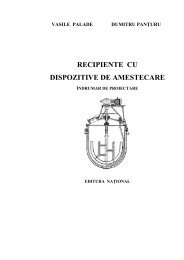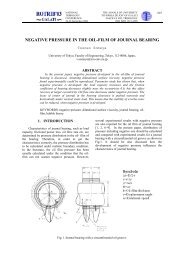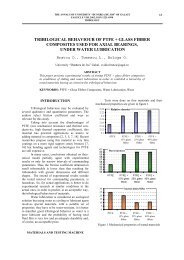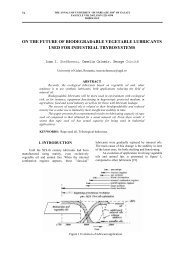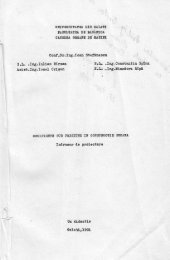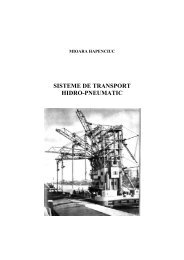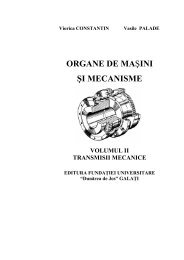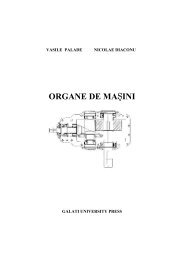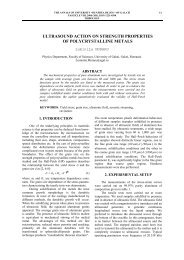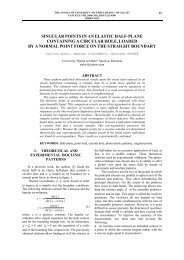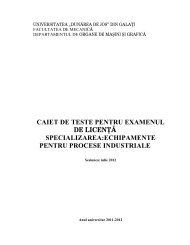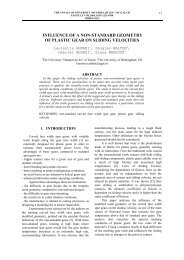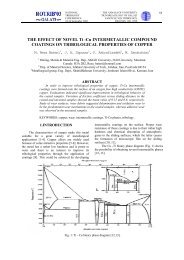flammability test data in risk assessment
flammability test data in risk assessment
flammability test data in risk assessment
You also want an ePaper? Increase the reach of your titles
YUMPU automatically turns print PDFs into web optimized ePapers that Google loves.
THE ANNALS OF UNIVERSITY “DUNĂREA DE JOS“ OF GALAŢI<br />
FASCICLE VIII, 2008 (XIV), ISSN 1221-4590<br />
TRIBOLOGY<br />
75<br />
In a full <strong>risk</strong> <strong>assessment</strong> the evaluator has to do<br />
a detailed exam<strong>in</strong>ation of both technical system and<br />
its environment and to perform a “full” <strong>in</strong>ventory<br />
(many accidents are the result of a “forgotten” aspect)<br />
of potential ignition sources. This will <strong>in</strong>clude the<br />
location and temperature of any hot surface, the<br />
presence of lagged pipes or the existence of unsealed<br />
electrical equipment etc. In normal function<strong>in</strong>g, if the<br />
surface temperatures the fluid might contact, were<br />
below the hot manifold ignition temperature (that<br />
means for ISO 20823 the fluid is <strong>in</strong> N category), then<br />
the source may be discounted <strong>in</strong> all but fault<br />
conditions. Tribology could help specialists to<br />
evaluate temperatures of different surfaces <strong>in</strong> relative<br />
motion, <strong>in</strong> critical scenarios (leak of lubricant, plastic<br />
deformations etc., total or partial remov<strong>in</strong>g of friction<br />
coat<strong>in</strong>gs etc.). The evaluator may develop the<br />
follow<strong>in</strong>g scheme for ignition on hot surfaces:<br />
- if normal function<strong>in</strong>g temperatures exceed the<br />
<strong>test</strong> hot manifold temperature T c , the ignition<br />
probability is 1,<br />
- for function<strong>in</strong>g temperatures below T c , the<br />
evaluator has to designate an ignition probability on a<br />
scale that could be zero for some fraction from T c<br />
(some specialists give 0.5T c or 0.75T c [27]),<br />
- additional ris<strong>in</strong>g of ignition probability when<br />
fault conditions are possible to happen.<br />
In some cases the evaluator could apply <strong>risk</strong><br />
<strong>in</strong>dex methods, calculat<strong>in</strong>g a “<strong>risk</strong> value” or a <strong>risk</strong><br />
<strong>in</strong>dex, based on the relationship:<br />
where<br />
a j<br />
= ∑ n<br />
<strong>risk</strong> j ⋅ j<br />
j=<br />
1<br />
I a r (1)<br />
is the attribute j related to <strong>risk</strong> evaluation<br />
(for <strong>in</strong>stance, ignition temperature on hot surface,<br />
smoke production, electrical ignition sources etc),<br />
j=1...n, and is a value associated to probability of<br />
r j<br />
occurrence and consequences. Both<br />
a j<br />
and<br />
r<br />
j<br />
have<br />
to be <strong>in</strong>troduced <strong>in</strong> a normalised scales. r j<br />
may have<br />
the follow<strong>in</strong>g values: 0 – the occurrence is not<br />
credible, 1 – unlikely, 2 – medium probability, 3 –<br />
highly likely. For the attribute of ignition on hot<br />
surfaces, the associated value could be related to<br />
the ignition temperature of the fluid <strong>in</strong>volved, but <strong>in</strong><br />
an <strong>in</strong>direct proportionality. For <strong>in</strong>stance, if the<br />
eng<strong>in</strong>eer had to select an <strong>in</strong>dustrial fluid among<br />
several with different hot surface ignition<br />
temperatures, T1〈 T 2...T<br />
〈 n, after <strong>test</strong><strong>in</strong>g under the<br />
procedure of ISO 20823, the fluid j has the<br />
normalised attribute<br />
a = T /T j (2)<br />
j<br />
It is obviously that a lower value of this<br />
attribute is desired for safety function<strong>in</strong>g and for a<br />
low probability of hazardous events. The problem to<br />
be solved is the compromise between <strong>in</strong>itial costs and<br />
performances of the fluid to be selected. Several<br />
decades ago the ratio between high security fluids and<br />
n<br />
r j<br />
hazardous fluids was as great as 5...3 to 1. For<br />
<strong>in</strong>stance, a fluid-power system will be more<br />
expensive when us<strong>in</strong>g water-based fluids due to the<br />
materials <strong>in</strong>volved <strong>in</strong> design<strong>in</strong>g (especially corrosion<br />
resistant steels, seal<strong>in</strong>gs etc.) as compared to a system<br />
with similar performances but us<strong>in</strong>g m<strong>in</strong>eral oils.<br />
Recently, specialists give design solutions that<br />
overpass only with 30...50% the classical ones that<br />
use more hazardous fluids [20].<br />
In m<strong>in</strong><strong>in</strong>g <strong>in</strong>dustry potential sources of ignition<br />
such as sparks, flames, electric arcs, high surface<br />
temperatures, acoustic energy, optical radiation and<br />
electro-magnetic waves have been identified <strong>in</strong> Directive<br />
92/104/EEC [7] as be<strong>in</strong>g potentially present <strong>in</strong> underground<br />
m<strong>in</strong>es (the discharge of static electricity, stray<br />
electric currents or discharges from malfunction<strong>in</strong>g<br />
electricity supply equipment that could produce overheat<strong>in</strong>g<br />
of surfaces or sparks capable of caus<strong>in</strong>g<br />
ignition, friction between mov<strong>in</strong>g surfaces or the<br />
entrapment of foreign bodies between mov<strong>in</strong>g<br />
surfaces caused, for example, by failures of<br />
mechanical plant, caus<strong>in</strong>g localised overheat<strong>in</strong>g, high<br />
surface temperatures present <strong>in</strong> <strong>in</strong>ternal combustion<br />
eng<strong>in</strong>es, brak<strong>in</strong>g systems, transmissions or exhausts,<br />
the use of smok<strong>in</strong>g or other materials that may be<br />
contraband <strong>in</strong> some m<strong>in</strong>es, exist<strong>in</strong>g fires caused by<br />
ignition of other flammable materials <strong>in</strong> the m<strong>in</strong>e).<br />
Industrial development depends also on hydraulic<br />
fluids, so their <strong>risk</strong> to fire has to be reduced by<br />
different means: modify<strong>in</strong>g their chemical<br />
composition <strong>in</strong> order to shift temperatures related to<br />
fire <strong>risk</strong>, mix<strong>in</strong>g fluids <strong>in</strong> order to enlarge the<br />
temperature range with no <strong>flammability</strong> or to reduce<br />
fire <strong>risk</strong>, design solution for avoid<strong>in</strong>g situations with<br />
fire <strong>risk</strong>, a cont<strong>in</strong>uous tra<strong>in</strong><strong>in</strong>g of operators, efficient<br />
fire suppression systems.<br />
The fire resistance of some hydraulic fluids may<br />
change with time or with operational service. Fireresistant<br />
fluids rely on their water content or their<br />
chemical composition and physical properties to<br />
provide fire resistance. Circumstances that could<br />
result <strong>in</strong> the reduction of the water content below its<br />
orig<strong>in</strong>al value or chemical or physical changes <strong>in</strong> the<br />
fluid could produce hard-to-estimate fire resistance.<br />
Such situations could arise through persistent high<br />
temperatures, fluid spillage where evaporation or<br />
separation could occur, or breakdown of fluid<br />
chemical properties dur<strong>in</strong>g use. No specific <strong>test</strong> has<br />
been designated to cater for these situations, which<br />
should be addressed through regular fluid monitor<strong>in</strong>g<br />
and good ma<strong>in</strong>tenance procedures. The <strong>risk</strong> <strong>assessment</strong><br />
should assess the likelihood of the fire<br />
resistance of a product be<strong>in</strong>g reduced <strong>in</strong> the application<br />
for which it is <strong>in</strong>tended. Other aspects such as<br />
environmental requirements may have to be considered<br />
and these may require additional or alternative<br />
safety precautions to be employed [9, 32, 40, 43].<br />
For reduc<strong>in</strong>g potential <strong>risk</strong>s it is very important to<br />
tra<strong>in</strong> employees on the <strong>risk</strong>s associated with any<br />
chemicals used at the operat<strong>in</strong>g site, the federal Right



